Address any questions or comments regarding this newsletter to the individual authors listed after each article or to its editors, Nathan Johanning, 618-939-3434, njohann@illinois.edu or Bronwyn Aly 618-695-6060, baly@illinois.edu. The Illinois Fruit and Vegetable News is available on the web at: http://ipm.illinois.edu/ifvn/. To receive or be removed from email notification of new postings of this newsletter, contact Nathan Johanning or Bronwyn Aly at the phone numbers or email addresses above.
In This Issue:
Upcoming Programs ((listings for beginning and established growers))
Regional Reports ((west central (x2), St. Louis metro east, southern Illinois, Dixon Springs))
Fruit and Vegetable Pest Management ((Modified Growing Degree Days from Jan 1 through April 30, New Video Series on Grape Fertility, Bronzed Strawberries is Caused by Eastern Flower Thrips, Orchards Sought For Insect Survey, Black Cutworm Flights Occurring))
Upcoming Programs
Check the Illinois SARE calendar for a full list of programs and links for registration.
http://illinoissare.org/ and http://illinoissare.org/calendar.php
Also see the University of Illinois Extension Local Food Systems and Small Farms Team’s website at:
http://web.extension.illinois.edu/smallfarm/ and the calendar of events at http://web.extension.illinois.edu/units/calendar.cfm?UnitID=629.
- 2019 Southern Illinois Summer Twilight Series Double Star Farms, Monday, May 20, 2019 at 6 p.m. The first Southern Illinois Summer Twilight Meeting will be held at Double Star Farms 16182 Mt. Zion Rd, Benton, IL. Mike Gehman and family will be hosting this meeting, highlighting their aggregation center, marketing, and production of vegetables. The meeting will start at their Benton location and will then move to the farm itself, which is located near Ewing, IL. For more information or to register, please contact Bronwyn Aly, baly@illinois.edu ; 618-252-8391.
- State Horticulture Field Day, Thursday, June 13, 2019, 8 a.m. Tanners Orchard, 740 State Rt. 40 Speer, IL 61479. Sponsored by the Illinois State Horticulture Society. For more details and tickets visit www.buytickets.at/ishs or Contact Charlene Blary at CBlary@ilfb.org or 309-557-2107
Regional Reports
From west central Illinois (Macomb)…Growers went from battling a freeze to now excess rainfall. These past two days we received nearly 4 inches of water (not counting what fell last night!). Soils were already flush with moisture, most of the rain that has fallen yesterday and today has been runoff.
High tunnels are planted and fields are almost all planted with the early season crops. A few growers had tomatoes outside in the ground and had to make some quick low tunnels for protection. Asparagus harvest is in full swing. Our hardneck garlic is a foot tall already.
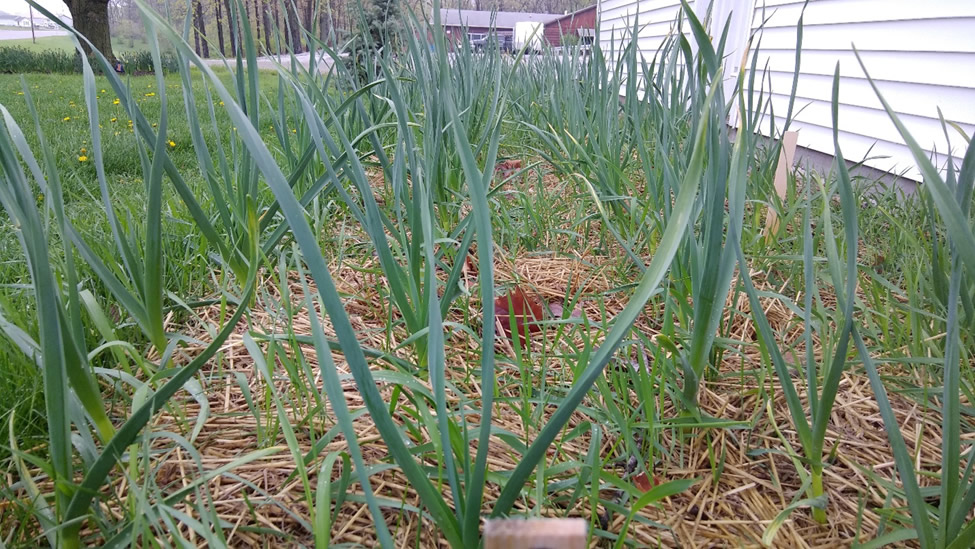
Hardneck garlic is looking good despite the winter, water, spring freezes, and weeds. Photo. C. Enroth
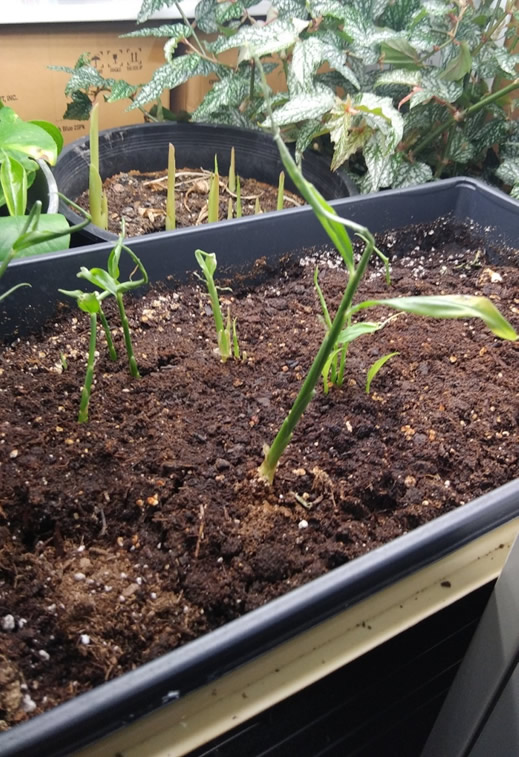
Ginger (foreground) and turmeric (background) have sprouted inside. We had a case of grasshoppers emerge from soil in the harvested turmeric. They hit the ginger quickly and defoliated a couple of sprouts. Two yellow sticky cards quickly took care of these unexpected indoor pests. Photo: C. Enroth.
Local rhubarb is also popping up in markets, restaurants and social media feeds. A quick note that the leaves of rhubarb contain oxalic acid, a toxin to us humans. During a freeze, the oxalic acid moves into the stems (petioles). If your rhubarb experienced a freeze or you aren’t sure, play it safe and do not harvest those stems. Cull any rhubarb stems exposed to freezing temperatures and wait for new growth.
No peach blooms again this year. Our frigid winter likely hit the flower buds hard. I recently read peach flower buds typically cannot survive a -12 degree Fahrenheit exposure (Penn State Extension). We certainly hit that mark over the winter.
Ginger and turmeric has sprouted. Now we wait for warmer weather to plant these in the tunnel.
Chris Enroth (309-837-3939; cenroth@illinois.edu)
From west central Illinois (Quincy)… Very little field work has been accomplished in our area, due to wet soils and slow drying. Since I started keeping track of rainfall this spring (March 24) we’ve had 19 days of precipitation (as I write this April 29) which probably isn’t uncommon for most of Illinois this spring. I was fortunate to get in the first planting of sweet corn on April 17, planted into soils just a tad bit wet in places. That evening we received 1.75” of hard rain, which topped several terraces and left ditches in fields. If you know anything about soils, the last thing you want is heavy rains on moist soils that were just planted, as crusting is a strong possibility. The fortunate thing is that we’ve been getting rains which keeps the soil moist and avoids a crust, so I believe the corn will eventually emerge. I’ve been checking base 50 growing degree days (isws.illinois.edu) and we’ve accumulated 110 (as of 4/29) since planting. Corn usually emerges around 110 or so, but based upon the seeds I’ve dug up, I don’t believe emergence will occur as timely as it usually does. This is probably an indication of soils that are cooler due to cloudy conditions and/or frequent cold rains holding soil temperatures lower. I utilize GDD to determine when the next planting of sweet corn should occur. It appears that this year will be difficult to get planted in a timely manner, thus there will be some skips in sweet corn availability. We have usually been able to supply sweet corn continually from day one to the end of harvest without missing any days.
We got our onions planted several weeks ago. We plant them on plastic to avoid weed issues. We use one trickle line and place 2 onions on either side of the drip line, spaced 5”. Likewise we have cole crops planted into plastic. Our tomatoes in the tunnels are close to needing staked and trellised. We finished picking the last of the spinach from the tunnels the day before we prepped the beds (tilled, fertilized and plastic laid) and planted tomatoes. Head lettuce transplants were placed midway between tomatoes at the edge of the raised beds, to not interfere with tomato growth.
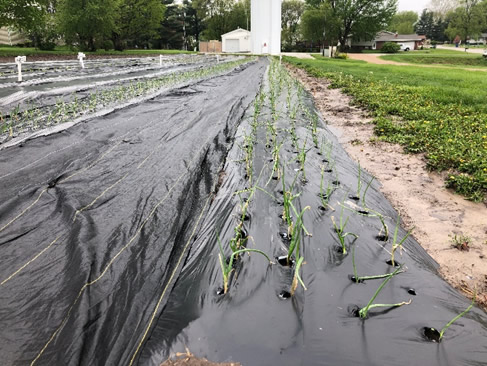
Plasticulture onions (left)
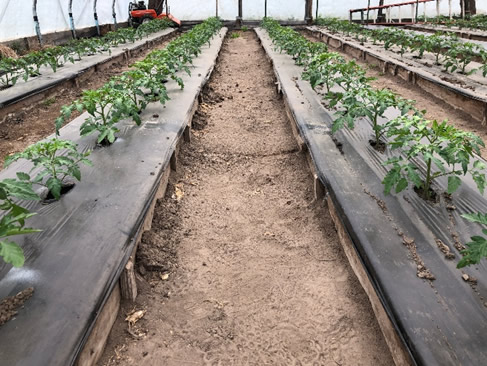
and high tunnel tomatoes (right). Photos: M. Roegge.
We began asparagus harvest April 18 with just a few pounds. We harvested some daily, but not a great amount. But then on April 22 and 23, growth exploded and we were spending most of the day harvesting and weighing! The 80 degree highs coupled with night lows in the 60’s caused tremendous growth. Then the morning of April 28, we recorded a low of 35 degrees. Luckily no frost occurred, probably due to warm soils (the high the day before was 70) and a slight wind all night long.
The first fertigation of plasticulture berries was made April 22. I’ll plan on weekly fertilization (5.5#N per acre per week) using KNO3 and CaNO3. Epsom salt once per week provides some magnesium and sulfur. We have a small percent of bloom so I’ll also be making our first fungicide spray this week. Luckily we didn’t lose any bloom due to the cold of Sunday morning. Looking back, in 2012 we started harvesting berries on 4/30, which was the earliest ever. Looks like this year may be the latest ever.
Our few apple trees (3 varieties) are in full bloom, and just a very few blooms are visible on our peach trees.
Mike Roegge, Retired Extension Educator & Mill Creek Farms (roeggem@illinois.edu)
From St. Louis metro-east… The region is still in a pattern of rain, leaving very small windows for field work to progress. This past Tuesday morning presented one such window and growers took advantage to seed sweet corn and plant transplants like tomato and pepper before another 2” downpour. Asparagus is in full harvest and plasticulture strawberries are at the green fruit stage. Apples are anywhere from petal fall to 10+ mm fruit. Peach is past shuck split and fruit are sizing. Grapes are at the 1-3” shoot stage, and growers should be thinking about fertilizer needs. See the note later in this issue for links to a 3 part video series put together by myself and Brad Taylor from SIU on grape fertility.
Elizabeth Wahle (618-344-4230; wahle@illinois.edu)
From southern Illinois... Rain, Rain, Rain! It is just wet and feels like it has been since about last September. Here in Murphysboro we have had 4”+ within the last week and more to come. A grower told me a old saying that “if it rains on the first of the month, you’ll have 15 more days of rain.” Well it rained May 1 and after looking at the forecast I think we will have our 15 days in by about the 10th! Generally, temperatures have stayed mainly in the 70s with a few days a bit higher or lower.
Out in the field things are very slowly progressing. There have been some very narrow windows of opportunity to get some field work done but that has been limited. There are some early plantings of sweet corn in that are up with 2-3 leaves. Asparagus harvest is coming in well. Asparagus beetles have been around, but not horrible; we have sprayed for them once. The wet weather has done no favors to any of our fruit crops especially the strawberries that are starting to come in. Make sure to do your best to keep fungicide coverage on our fruit crops as best you can. Now is the time of year that our cover crops really take off, sometimes faster than we can keep up with them. The cereal rye that I reported 2 weeks ago about 1 ft tall is not 3 ½ ft tall. This can be a good thing if you want to no-till or a challenge if you were planning to till it under. Consider using a herbicide to terminate covers you want to till under if the weather is working against you and you want to manage the amount of biomass you have to till in. Note also especially in these wet conditions, that a living cover crop will actually help to suck up excess moisture and dry things out (once it stops raining). Here’s to a break in the rain hopefully sooner than later!
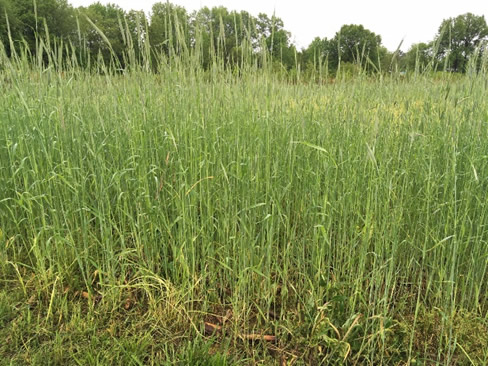
Current cereal rye growth. Photo: N. Johanning
Nathan Johanning (618-687-1727; njohann@illinois.edu)
From Dixon Springs Ag Center…
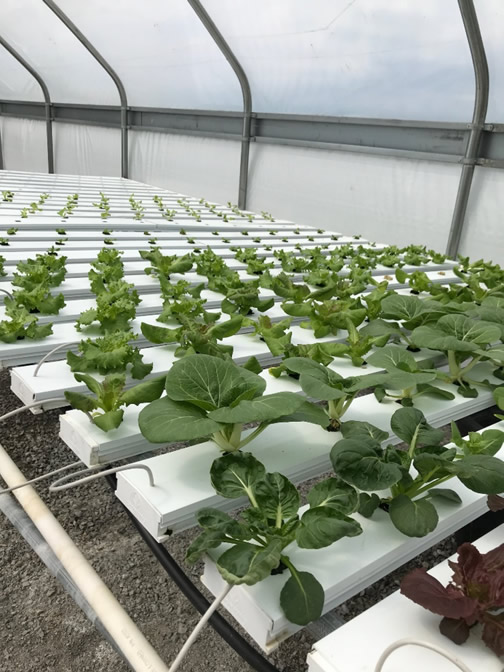

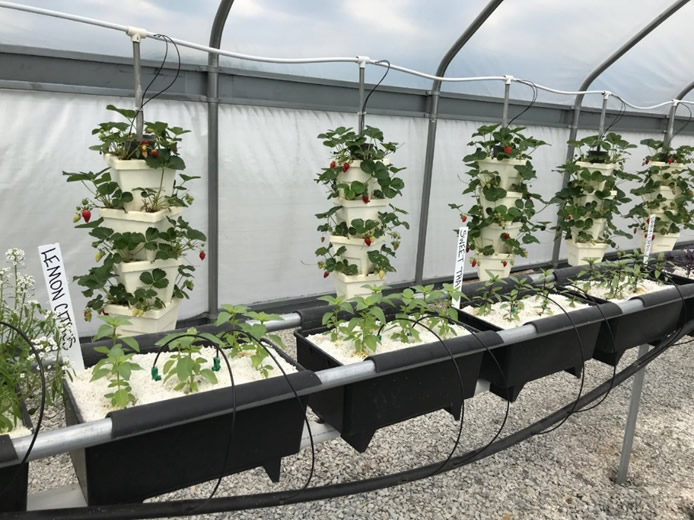
Photos starting at top left: NFT recirculating table with lettuce, pak choi, and tat soi. We stagger planting date by 2 weeks to maintain a fresh rotation of greens. Strawberries are ripening quickly now, with several really nice fruit clusters. Various herbs are growing in the elevated rail system. Photos: B. Aly.
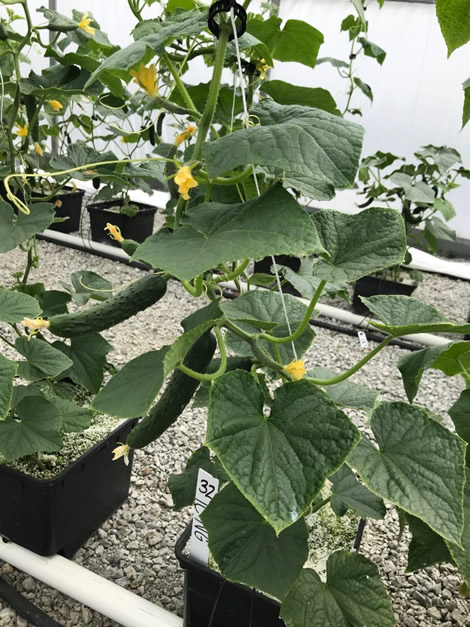
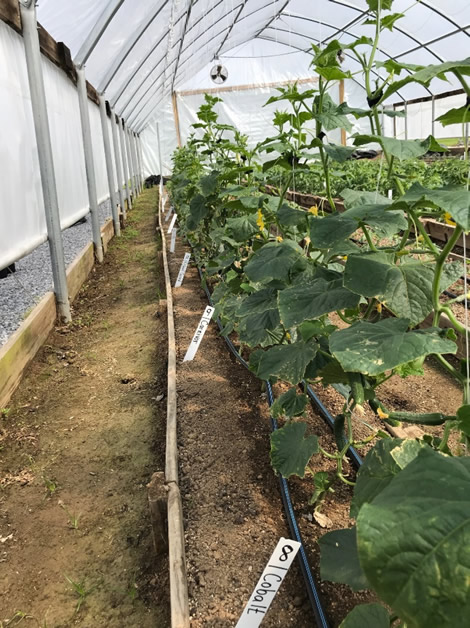
Top photos: Grafted cucumber trial vines are growing well in both the hydroponic and in ground plots but the hydroponic plots are definitely off to a much quicker start, with harvests starting last week on over half of the plots. In both systems, the vines are trained and pruned to a single stem on a single string trellis. Bottom photos show a couple of different inter-plantings we are utilizing in the ground beds. Lettuce planted along the east side of the determinate tomato row and onions planted between celery. Photos: B. Aly.
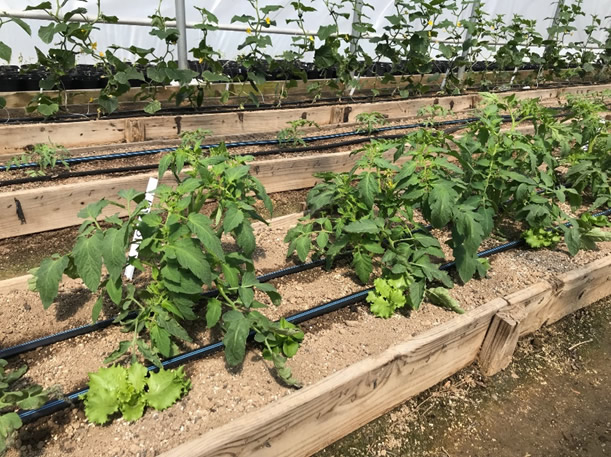
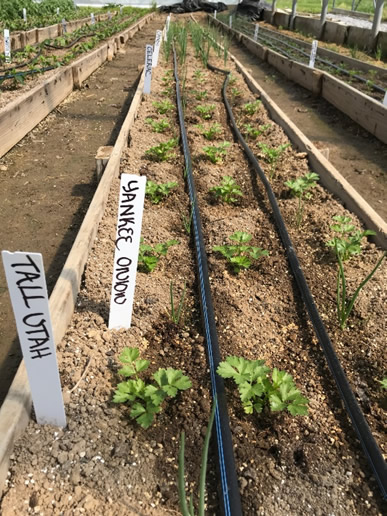
Like much of the rest of the state, we continue to see rain periods every other day to two days. As I look out the window of the office here at DSAC, Millstone Bluff to the north is in a complete white out as the latest afternoon shower is passing through. Fortunately for us, our plots are inside high tunnels, so we are not feeling the impact of not being able to get field work accomplished. Tomorrow’s agenda will include pruning, staking, and tying the determinate tomato plots, harvesting cucumbers and strawberries, and hopefully steaming the beds in the youth high tunnel. The ‘Monterey’ strawberries are staying very firm, setting large fruit, and the flavor is really good. No signs of spider mites yet. Plasticulture strawberry harvest has begun in southern Illinois. As an aside, I have to admit that I ate my very first piece of rhubarb pie yesterday and it was fantastic. I am not sure why it has taken so many decades for this discovery but I am a fan!
Bronwyn Aly (618-382-2662; baly@illinois.edu)
Fruit and Vegetable Pest Management
Modified Growing Degree Days (Base 50⁰ F, January 1 through April 30)
Insect development is temperature dependent. We can use degree days to help predict insect emergence and activity. Degree day accumulations calculated using the Pest Degree-Day Calculator
Station Location |
Actual Total |
Historical Average (11 year) |
One- Week Projection |
Two-Week Projection |
Freeport |
136 |
154 |
195 |
263 |
St. Charles |
137 |
153 |
191 |
256 |
DeKalb |
129 |
174 |
192 |
266 |
Stelle |
157 |
211 |
225 |
306 |
Peoria |
201 |
242 |
273 |
358 |
Monmouth |
174 |
215 |
241 |
321 |
Champaign |
240 |
244 |
312 |
399 |
Springfield |
272 |
279 |
351 |
447 |
Perry |
279 |
284 |
351 |
438 |
Brownstown |
309 |
338 |
393 |
493 |
Olney |
334 |
326 |
416 |
514 |
Belleville |
381 |
369 |
468 |
571 |
Rend Lake |
395 |
403 |
488 |
599 |
Carbondale |
416 |
395 |
504 |
605 |
Dixon Springs |
462 |
440 |
555 |
663 |
Kelly Estes, State Survey Coordinator, Illinois Cooperative Agricultural Pest Survey (217-333-1005; kcook8@illinois.edu)
New Video Series on Grape Fertility
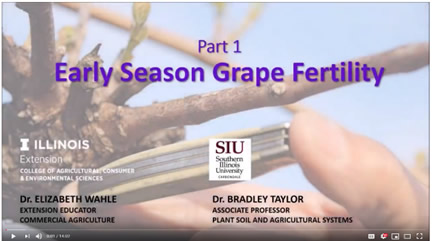
Brad Taylor, Southern Illinois University and I just completed a video series on fertilizing grapes and can be found at:
Part 1 https://youtu.be/5k6_3mvKRIM
Part 2 https://youtu.be/Cl99FmQKfZg; and
Part 3 https://youtu.be/eLefvsC900c.
Elizabeth Wahle (618-344-4230; wahle@illinois.edu)
Bronzed Strawberries is Caused by Eastern Flower Thrips

Eastern flower thrip. Photo: E. Wahle
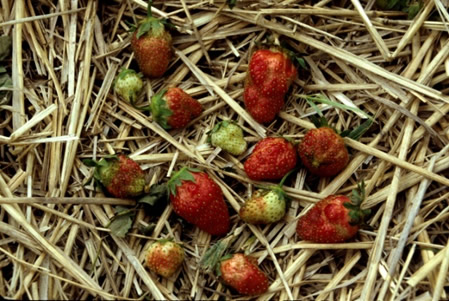
Thrip-damaged strawberry fruit. Photo: E. Wahle
Eastern flower thrips, Frankliniella tritici, make their presence known in strawberry patches annually in Illinois. Damaged fruit is typically tan, brown or yellow-brown in color, hence the term “bronzing.” The disorder occurs annually to some extent, but timing of its occurrence and severity varies from year to year. Bronzing of strawberry fruit often occurs in late spring and summer in Illinois. In some years, bronzing can result in a total loss due to unmarketable or undesirable fruit. The eastern flower thrips is a tiny, slender, cigar shaped insect. Nymphs and adults have the same general shape. Nymphs are wingless, whitish yellow when small, and yellow when fully grown. Adults are yellowish brown, 1/16 inch long, and have narrow wings that are fringed with hairs. While resting, the wings are folded lengthwise over the back. Adults are attracted to flowers of many different plants, including many plants in family Rosaceae. Adults and nymphs feed using rasping-sucking mouthparts to obtain sap. On strawberry fruit, they begin feeding on seeds soon after the buds open. They feed on the tissue between the seeds as the fruit expands. Bronzing results from surface cells being killed. Eastern flowers thrips are not thought to overwinter in Illinois, but populations are thought to develop every year throughout the state as a result of long-distant migrations from southern states on high-level winds associated with weather fronts. There are two active nymph stages and two inactive pupal-like nymph stages. The life cycle can be completed in several weeks, resulting in several generations per year. Because eastern flower thrips are very small, they are difficult to view with the naked eye. To aid in their detection, tap flowers onto a white or very dark plate, and look for the slender yellow thrips. Thrips are also visible within the strawberry flower structure with the aid of a 10x magnifying lens. Thrips immigration is not a one-time event, so control has to be maintained throughout the critical bloom period of strawberries. Although thresholds have not been determined for the Midwest, data from outside growing areas suggests that control is warranted if counts of thrips exceed 2 to 10 per blossom. If harvest is already under way, control is recommended for unaffected fruit less than dime in diameter when thrips are detected at or above the threshold level. Sample when first blossom buds begin to open. Threshold is 2-10 thrips per blossom. Treat before widespread bloom draws pollinators. Entrust, Radiant and Sivanto Prime carry labels for control of eastern flower thrips in strawberries. Lorsban, Danitol, and Brigade are not labeled specifically for eastern flower thrips control in strawberries but have been effective in field use at rates listed for clipper
or spittlebug and tarnished plant bug. In all cases, watch PHIs closely.
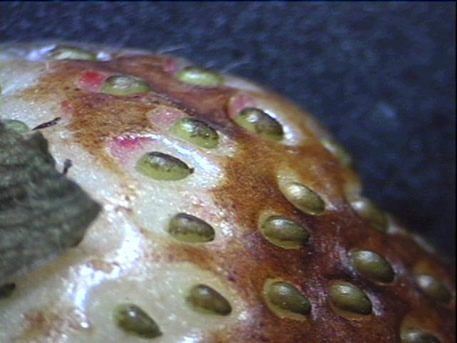
Close-up of thrip damage to strawberry fruit. Photo: E. Wahle
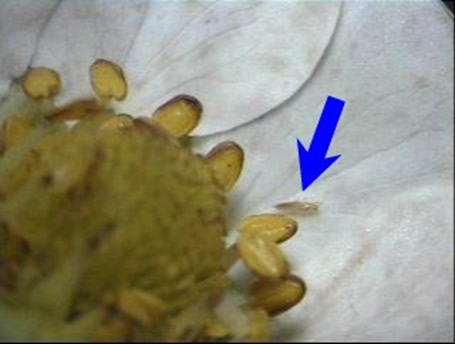
Blue arrow points to eastern flower thrip on strawberry flower. Photo: E. Wahle
Elizabeth Wahle (618-344-4230; wahle@illinois.edu)
Orchards Sought For Insect Survey
As part of the Illinois Cooperative Agricultural Pest Survey program, we will once again start a three-year period where we will be surveying orchards in Illinois for potential invasive species – both insects and disease. Specialty crops represent a significant portion of Illinois’ agricultural production. As with any commodity, several pests can negatively impact fruit production and the industry at large. Several of these pests are invasive species that are not known to occur in Illinois but are included on the USDA-APHIS-PPQ Priority List of invasive species threats, such as light brown apple moth, summer fruit tortrix moth, and false codling moth. Other targeted pests include those that are currently present in the state and causing damage, such as spotted wing drosophila and brown marmorated stink bug. With the introduction threat of the spotted lanternfly from the east coast also looming, it is vitally important to have these detection surveys.
What I am looking for specifically, is the permission to trap and survey orchards from June through early September. Myself and my team will place traps in the orchards and return to check and change them every other week. During these visits we will also be conducting visual surveys for these invasive pests and pathogens. We require no effort on your part and operate “business as usual”.
We have had wonderful cooperators in the past and look forward to connecting with more this year. If you are interested in participating please email Kelly at kcook8@illinois.edu or call 217-333-1005.
Kelly Estes, State Survey Coordinator, Illinois Cooperative Agricultural Pest Survey (217-333-1005; kcook8@illinois.edu)
Black Cutworm Flights Occurring
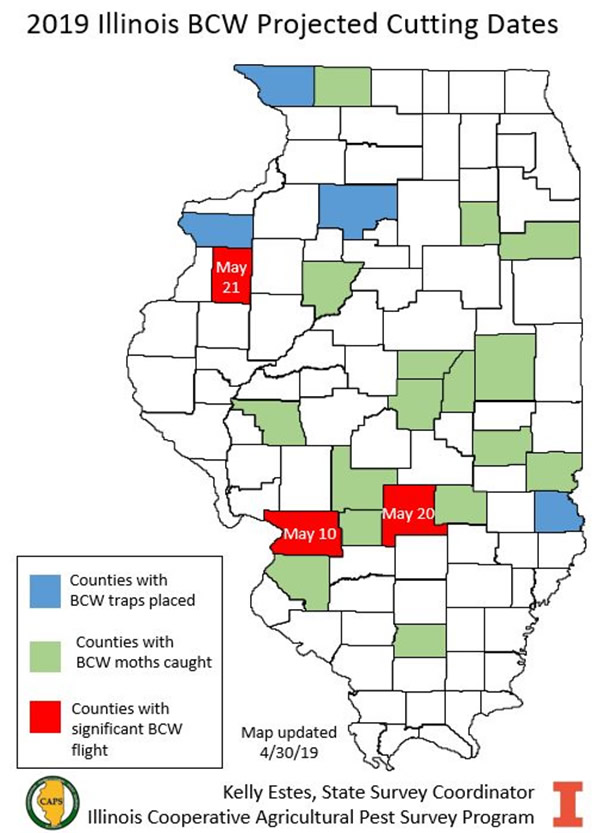
Our insect monitoring program is in full swing. Two spring insects that are monitored as they move into Illinois from the south are the black cutworm and true armyworm. While many of our cooperators are corn and soybean producers, both of these pests can be a cause for concern for Illinois vegetable producers, for sweet corn and more.
Each week, our trapping volunteers submit their trap counts for summary. Below is the current map of where black cutworm moths have been reported as well as significant flights. Significant flights occur when 9 or more moths are caught over the course of two nights. When this happens, we can begin calculating degrees to help predict insect development, specifically then 4th instar larvae may be present. It is at this stage when plant cutting occurs.
More information on black cutworm along with economic treatment thresholds for sweet corn, snap bean, potatoes, and leafy greens can be found here: http://labs.russell.wisc.edu/vegento/pests/black-cutworm/
Kelly Estes, State Survey Coordinator, Illinois Cooperative Agricultural Pest Survey (217-333-1005; kcook8@illinois.edu)
Less Seriously
Being the Star Wars fan that I am, I couldn’t not put a couple of memes in the newsletter ahead of May the 4th be with you, coming this Saturday.
https://www.thoughtco.com/funny-political-star-wars-memes-2733874


University of Illinois Extension Specialists in Fruit and Vegetable Production & Pest Management
Extension Educators – Local Food Systems and Small Farms |
||
Bronwyn Aly, Gallatin, Hamilton, Hardin, Pope, Saline, and White counties |
618-382-2662 |
|
Katie Bell, Franklin, Jackson, Perry, Randolph, & Williamson counties |
618-687-1727 |
|
Sarah Farley, Lake & McHenry counties |
847-223-8627 |
|
Nick Frillman, Woodford, Livingston, & McLean counties |
309-663-8306 |
|
Laurie George, Bond, Clinton, Jefferson, Marion, & Washington counties |
618-548-1446 |
|
Zachary Grant, Cook County | 708-679-6889 | |
Doug Gucker, DeWitt, Macon, and Piatt counties |
217-877-6042 |
|
Erin Harper, Champaign, Ford, Iroquois, and Vermillion counties |
217-333-7672 |
|
Grace Margherio, Jackie Joyner-Kersee Center, St. Clair County |
217-244-3547 |
|
Grant McCarty, Jo Daviess, Stephenson, and Winnebago counties |
815-235-4125 |
|
Katie Parker, Adams, Brown, Hancock, Pike and Schuyler counties |
217-223-8380 |
|
Kathryn Pereira, Cook County |
773-233-2900 |
|
James Theuri, Grundy, Kankakee, and Will counties |
815-933-8337 |
|
Extension Educators – Horticulture |
||
Chris Enroth, Henderson, Knox, McDonough, and Warren counties |
309-837-3939 |
|
Richard Hentschel, DuPage, Kane, and Kendall counties |
630-584-6166 |
|
Andrew Holsinger, Christian, Jersey, Macoupin, & Montgomery counties |
217-532-3941 |
|
Extension Educators - Commercial Agriculture |
||
Elizabeth Wahle, Fruit & Vegetable Production |
618-344-4230 |
|
Nathan Johanning, Madison, Monroe & St. Clair counties |
618-939-3434 |
|
Campus-based Extension Specialists |
||
Kacie Athey, Entomology |
217-244-9916 |
|
Mohammad Babadoost, Plant Pathology |
217-333-1523 |
|